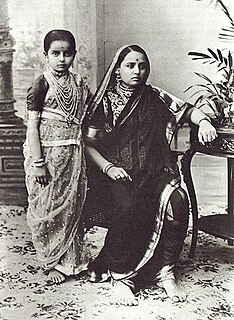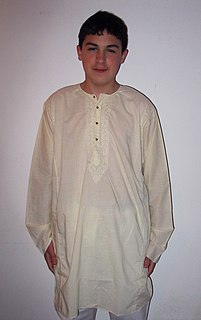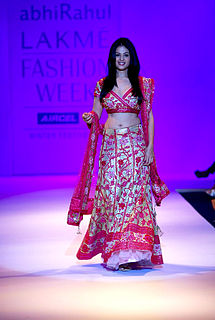
A skirt is the lower part of a dress/gown or a separate outer garment that covers a person from the waist downwards.

A sari, saree or sharee is a women's garment from the Indian subcontinent that consists of an unstitched drape varying from 4.5 to 9 metres in length and 600 to 1,200 millimetres in breadth that is typically wrapped around the waist, with one end draped over the shoulder, partly baring the midriff. There are various styles of sari manufacture and draping, the most common being the Nivi style, which originated in the Deccan region. The sari is worn with a fitted bodice commonly called a choli and a petticoat called ghagra, parkar or ul-pavadai. In the modern Indian subcontinent, the sari is considered a cultural icon.

A kurta is a loose collarless shirt worn in many regions of South Asia, and now also worn around the world. Tracing its roots to Central Asian nomadic tunics, or upper body garments, of the late-ancient- or early-medieval era, the kurta has evolved stylistically over the centuries, especially in the South Asia, as a garment for everyday wear as well as for formal occasions.
Clothing in India is dependent upon the different ethnicity, geography, climate, and cultural traditions of the people of each region of India. Historically, male and female clothing has evolved from simple garments like kaupina, langota, dhoti, lungi, sari, gamcha, and loincloths to cover the body into elaborate costumes not only used in daily wear, but also on festive occasions, as well as rituals and dance performances. In urban areas, western clothing is common and uniformly worn by people of all social levels. India also has a great diversity in terms of weaves, fibers, colours, and material of clothing. Sometimes, color codes are followed in clothing based on the religion and ritual concerned. The clothing in India also encompasses the wide variety of Indian embroidery, prints, handwork, embellishment, styles of wearing clothes. A wide mix of Indian traditional clothing and western styles can be seen in India.

Garba is a form of dance which originates from the state of Gujarat in India. The name is derived from the Sanskrit term Garbha ("womb") and Deep. Many traditional garbas are performed around centrally lit lamp or a picture or statue of the Goddess Shakti. Traditionally, it is performed during the nine-day Hindu festival Navarātrī. Either the lamp or an image of the Goddess, Durga is placed in middle of concentric rings as an object of veneration.

A choli is a blouse or a bodice-like upper garment that is commonly cut short leaving the midriff bare, it is worn along with a sari in the Indian subcontinent. The choli is also part of the ghagra choli costume in the Indian subcontinent.

In fashion, the midriff is the human abdomen. The midriff is exposed when wearing a crop top or some forms of swimwear. Cholis worn by Indian women expose a section of midriff, usually 4 to 5 inches.

Lehnga or langa, is a form of full ankle-length skirt worn by women from India which is long, embroidered and pleated. It was worn in old Hindu tradition and was believed to awaken the spiritual chakras of the body. It is worn as the bottom portion of a Gagra choli or Langa Voni. It is secured at the waist and leaves the lower back and midriff bare. In the Indian subcontinent, various types of traditional embroidery work are done on lehenga, with Gota patti embroidery being one of popular types for the festivals and weddings. In the earlier times, girls would wear Ghagra-choli. Today, this attire has become outdated. Even then, in States like Gujarat and Rajasthan, young girls and women still wear lehnga. Lehnga is one of the appropriate garments as per the Hindu culture and considered a sattvik garment at the spiritual level as well.

A langa voni is a traditional dress worn mainly in South India and Pakistan by young girls between puberty and marriage. It is also known as the two-piece sari or half sari. Young girls between puberty and marriage wear this dress. Girls younger than this may wear it on special occasions.
Shisheh or abhla bharat embroidery, or mirror-work, is a type of embroidery which attaches small pieces of mirrors reflect metal to fabric. Mirror embroidery is spread throughout Asia, and today can be found in the traditional embroidery of the Indian subcontinent, Afghanistan, China, and Indonesia.
Pakistani clothing refers to the ethnic clothing that is typically worn by people in the country of Pakistan and by the people of Pakistani origin. Pakistani clothes express the culture of Pakistan, the demographics of Pakistan and cultures from the Punjab, Sindh, Balochistan, Khyber Pakhtunkhwa (Pashtun) and Kashmir regions of the country. Dress in each regional culture reflect weather conditions, way of living and distinctive style which gives it a unique identity among all cultures.

Low-rise is a style of clothing designed to sit low on, or below, the hips. The style can also be called lowcut, hipster, or hip-hugger. and can apply to garments worn by males or females. The term can be applied to all garments that cover the wearer's crotch area, including trousers, jeans, shorts, skirts, panties, briefs, bikinis, pantyhose, and tights.

A lehenga-style sari is a modern garment introduced in India that blends elements of the traditional sari and lehenga choli. A lehenga-style sari is normally 4.5 metres to 5.5 metres long. To wear one, unlike a sari, one does not have to form pleats but may simply tuck and drape.

Indian wedding clothes are elaborate set of clothes worn by the bride, bridegroom and other relatives attending the wedding.

Shalwar kameez is a traditional combination dress worn by women, and in some regions by men, in South Asia, and Central Asia.

The Punjabi ghagra is a four-piece outfit known as tewar or 'ti-or' which was traditionally worn by Punjabi women throughout the Punjab region with the outfit comprising a head scarf (Phulkari), kurta or kurti, ghagra and either a suthan or the Punjabi salwar. In modern times, the ghagra is worn by women in parts of Haryana, rural parts of south West Punjab, parts of Himachal Pradesh and during performances of Giddha in East Punjab.

The luanchari is a full-dress ethnic garment of India. It is made up of two parts stitched together: the upper part, or choli, is a kind of blouse or bodice, and the lower part, or lehanga, is a long skirt. The two parts are typically made from the same fabric, but may vary in colour.

In the ancient Punjab region, people wore cotton clothing. The tops lied till knees for both the genders. A scarf was worn over the tops which would be draped over the left shoulder and under the right. A large sheet would be further draped over one shoulder which would hang loose towards the knees. Both sexes wore a dhoti around the waist. Modern Punjabi dress has retained this outfit but over its long history has added other forms of dress.

Sindhi women wear the Shalwar kameez or the sari and the men wear the shalwar kameez or the kurta with pyjamma. However, before the adoption of the Shalwar kameez, the sari and the kurta, Sindhi's had their own traditional costumes.

History of clothing in the Indian subcontinent can be traced to the Indus Valley Civilization or earlier. Indians have mainly worn clothing made up of locally grown cotton. India was one of the first places where cotton was cultivated and used even as early as 2500 BCE during the Harappan era. The remnants of the ancient Indian clothing can be found in the figurines discovered from the sites near the Indus Valley Civilisation, the rock-cut sculptures, the cave paintings, and human art forms found in temples and monuments. These scriptures view the figures of human wearing clothes which can be wrapped around the body. Taking the instances of the sari to that of turban and the dhoti, the traditional Indian wears were mostly tied around the body in various ways.


































